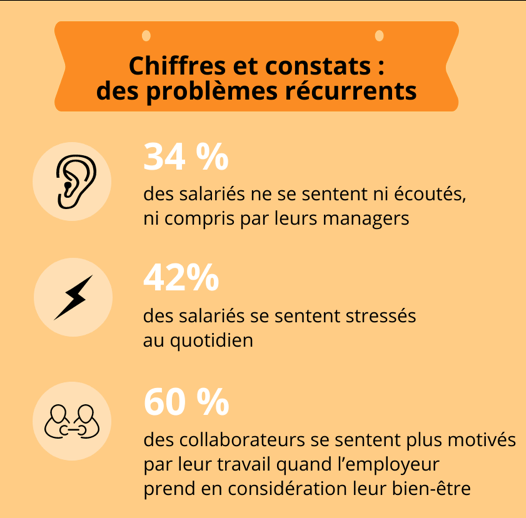As part of your daily routine, the level of requests to express your opinion is constantly on the rise. Whether on TripAdvisor (travelers of yesteryear will remember), Airbnb, Uber, Amazon, and many others.
After the slightest action, whether it’s a brief 90-second exchange with your bank advisor or an Orange operator, you end up with a satisfaction form to fill in. It’s a benchmark of our digital age.
It can be pleasant, sometimes monotonous, but it at least brings the notion that your opinion counts.
As a business leader, manager or perfectionist (select the appropriate term), you make it a point of honor to measure customer satisfaction, constantly seeking to optimize this experience. But have you also considered the importance of tracking the satisfaction of your employees?
In today’s environment, your employees, like you, are regularly asked for their opinions. Sometimes, they share it spontaneously, without even being asked – hello social networks.
At Furious, we make employee satisfaction a top priority, seeing it as essential to successful business management. The right equipment, such as good management software, is crucial to managing these aspects. Employee motivation and well-being play an essential role in the success of any business.
What is job satisfaction and why is it essential?
Job satisfaction isn’t just a “nice word” thrown around. It represents anemployee’s well-being, sense of accomplishment andcommitment to his or her job and work environment. When an employee is satisfied, he or she invests more, takes initiative and is more inclined to adapt to change. Here’s why it’s crucial:
- Involvement: a satisfied employee is a committed employee. They take their missions to heart and get involved in the company's projects.
- Talent retention: job satisfaction is a key factor in retaining talent. A happy employee is less inclined to look elsewhere.
- Productivity: satisfied employees are often more productive. They are motivated and focused, which translates into better quality work.
Why is employee satisfaction central to a company's success?
Just as an engine needs fuel to run, a company needs its employees to thrive. If your employees are satisfied, not only will they work with passion, but they’ll also become ambassadors for your brand.
- Work atmosphere: a positive environment is contagious. When employees are happy, the general atmosphere in the company is more pleasant, which is good for everyone.
- Brand image: satisfied employees speak highly of their company. This strengthens your brand image, both internally and externally.
- Innovation: an employee who feels valued and listened to is more likely to come up with innovative ideas.
How does job satisfaction influence employee productivity and loyalty?
The correlation between job satisfaction, productivity and loyalty is strong. A satisfied employee is more likely to remain loyal to the company and to give his or her best.
- Less absenteeism: a happy employee is less likely to fall ill or be absent frequently.
- Less turnover: employee loyalty is directly linked to employee satisfaction. Fewer departures means lower recruitment and training costs for new arrivals.
- Efficiency: an employee who enjoys what he or she does will be more efficient and make fewer mistakes.
How do companies with highly satisfied employees stand out?
In an increasingly competitive business world, standing out from the crowd is essential. And there’s nothing like happy, committed employees to make the difference.
- Strong corporate culture: companies recognized for their excellent job satisfaction often have a strong corporate culture, where every employee feels valued.
- Professional development: these companies invest in the training and development of their employees, ensuring that they continue to improve their skills.
What are the recognized reasons for job satisfaction in the sector?
Each sector has its own specificities, but some reasons for job satisfaction are universal:
- Acknowledgement: gratitude and recognition for a job well done.
- Work/life balance: balancing career and personal life.
- Career opportunities: clear, accessible development prospects.
What tangible examples demonstrate the impact of job satisfaction?
- Testimonials: happy employees often share their positive experiences, whether in interviews, on review sites or on social networks.
- Awards: many companies have won awards and certifications for their excellent job satisfaction.
- Growth: companies that focus on employee satisfaction often see faster, more stable growth.
From an internal point of view
"Enter what I think. What I want to say. What I think I say. What I say. What you want to hear. What you hear. What you understand... There are ten ways in which we can have trouble communicating. But let's try anyway..."
Bernard Werber
In our TOP 20 corporate management mistakes , it’s a fact that no-one is immune to communication or management errors. In stressful situations, whether inherent to the company or not, it’s not always easy to make oneself understood or heard.
However, listening is the key to making up for any management blunders.
It therefore seems essential to solicit this feedback at obvious stages: end of project, HR follow-up, team needs, etc. And to automate this process to ensure regular quantitative and qualitative feedback. And to automate this process to ensure regular quantitative and qualitative feedback.
This brings 2 essential advantages:
- This will enable you to highlight potential problems, tensions and misunderstandings well in advance. And remedy them before you end up with the hot potato that managers dread.
- On the other hand, certain sectors, such as digital agencies and ESNs, are subject to fierce HR competition: turnover is high, and a big salary is not enough to retain good employees. An employee who feels heard and taken into account will appreciate it, and this will contribute to building loyalty.

Sources: Les Echos and Ifop
From an external point of view
First of all, the employee is often the customer’s shop window: so it’s vital to keep an overview of what’s going on between them in order to anticipate problems and collateral damage.
Measuring employee satisfaction is therefore the logical counterpart to measuring customer satisfaction.
What’s more, beyond the customer, the entire prospecting and recruitment chain can be affected by poor employee satisfaction.
In the age of social networks and Glassdoor, your followers are likely to give their opinions publicly, whether on the spot or not, without your knowledge or control.

The #BalanceYourAgency phenomenon has had a major impact on the industry. Some of the issues raised could surely have been dealt with internally. And the iceberg would have been detected much earlier, without having to go through the “let’s wash our dirty laundry in public” process*.
How do you effectively measure employee satisfaction?
In an ever-changing business environment, it’s essential to regularly assess the pulse of your employees. Measuring employee satisfaction is more than just asking a few questions at an annual performance review. It’s an ongoing process that requires the right tools and techniques.
What are the key indicators of employee satisfaction?
Key indicators may vary from company to company, but here are a few universally recognized ones:
- Turnover rate: a high turnover rate may indicate a satisfaction problem.
- Absenteeism rate: frequent absences may be a sign of dissatisfied or demotivated employees.
- Direct feedback: individual interviews, focus groups or suggestion boxes.
- Satisfaction survey results: a valuable source of information on how employees feel.
Why is it crucial to conduct regular employee satisfaction surveys?
Conducting regular surveys is the key to understanding your employees’ changing needs:
- Constant evolution: employee needs and expectations are changing. What worked a year ago may no longer be relevant today.
- Anticipate problems: waiting for a problem to become visible can be too late. Surveys enable you to identify potential problems at an early stage.
- Commitment: showing employees that their opinions count strengthens their commitment to the company.
How do you design an employee satisfaction questionnaire?
A positive work environment is not only good for employees, but also for the company. It improves productivity, reduces turnover and strengthens the brand image.
How to identify and remedy sources of potential dissatisfaction?
- Active listening: it's essential to create an environment where employees feel free to share their concerns.
- Regular analysis: frequently evaluate survey data and key indicators.
- Rapid implementation: once you've identified a problem, act quickly to solve it.
What strategies can be put in place to improve employee satisfaction?
- Training programs: investing in ongoing training shows employees that you care about their development.
- Benefits: competitive benefits can make a big difference in employee perception.
- Recognition: rewards and recognition programs to recognize individual contributions.
- Flexibility: offer flexible working hours or telecommuting options to improve work/life balance.
Going beyond employee satisfaction: aligning with customer expectations
While employee satisfaction remains crucial, it’s just as vital for a company to focus on customer satisfaction. After all, a satisfied customer can lead to a happy employee. Aligning customer expectations with those of employees can create a synergy that propels the company towards lasting success.
What are the 4 main expectations of customer satisfaction?
Customers, whatever their origin or sector of activity, tend to share certain fundamental service expectations:
- Product or service quality: customers expect the product or service they buy to be of the highest quality and to meet their needs.
- Excellence in customer service: prompt, competent and courteous assistance can often mean the difference between a loyal customer and a lost one.
- Value for money: customers are looking for value for their money. This doesn't always mean the cheapest product, but rather something worthwhile.
- Integrity and transparency: customers want to deal with honest companies that keep their promises and communicate openly.
How can customer satisfaction indicators influence employee satisfaction?
Customer satisfaction and employee satisfaction are closely linked. Here’s how customer satisfaction indicators can have an impact:
- Positive reflection: when customers are satisfied and let us know it, it boosts employee morale. They feel valued and recognized for their work.
- Continuous improvement: customer feedback can highlight areas for improvement, offering employees opportunities for training and development.
- Alignment of objectives: when employees understand what customers expect, they can better align themselves with these expectations, leading to better overall satisfaction.
- Reinforced corporate culture: a culture focused on customer satisfaction also encourages employees to excel, creating a more positive and collaborative working environment.
Track employee satisfaction with Furious
Of course, it’s very frustrating to discover dissatisfaction and frustration after the fact on public platforms. But once again, anticipate potential problems. Take them into account and react. And you’re likely to turn a disgruntled employee into an ambassador for your company.
Furious saves our customers an average of 20% of their management time. That’s 1 full day of your working week. Yeah, right.
Like a virtual assistant, the tool will be there to remind you of your employees’ birthdays. But it’s also there to track their satisfaction at the end of a project, whether with the project itself, the customer or the associated team.
It will also be your partner for interviews and performance monitoring. The interface that will communicate your teams’ needs to you (yes, that’s where they’ll ask you for a new ping-pong table #TrueStory).
In short, there’s much more to corporate management than project management and customer follow-up. An effective strategy also relies on human resources management that values employees and monitors their satisfaction on an ongoing basis. Your resources are precious, because they are at the heart of your added value. So it’s essential to adopt a clear, structured approach to understanding and improving their day-to-day experience.